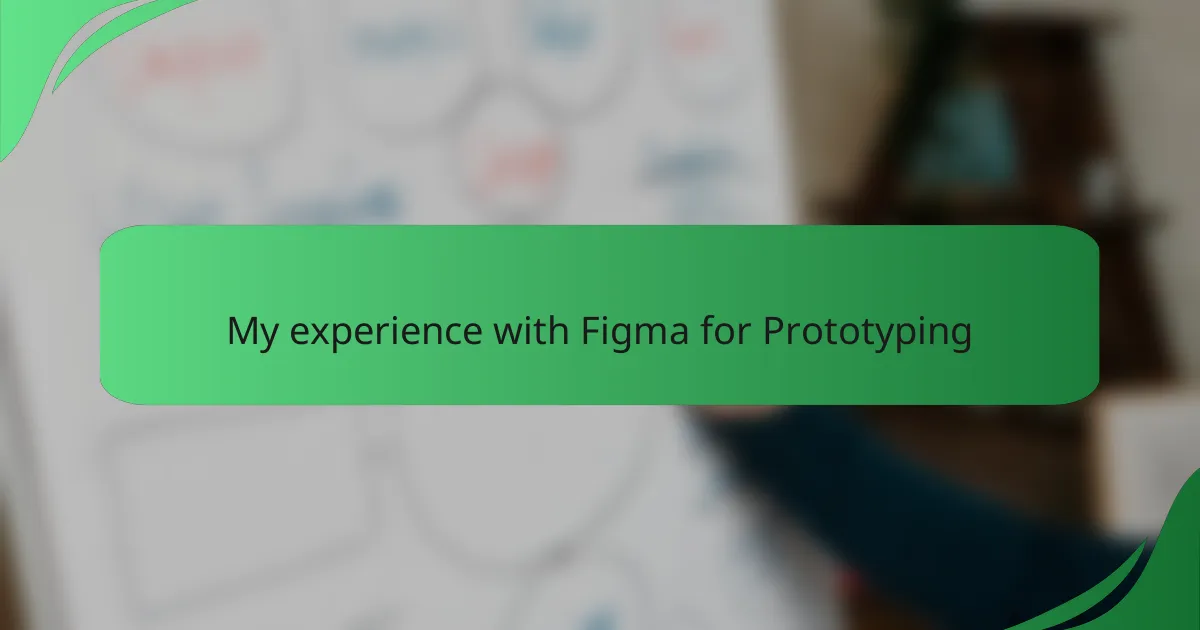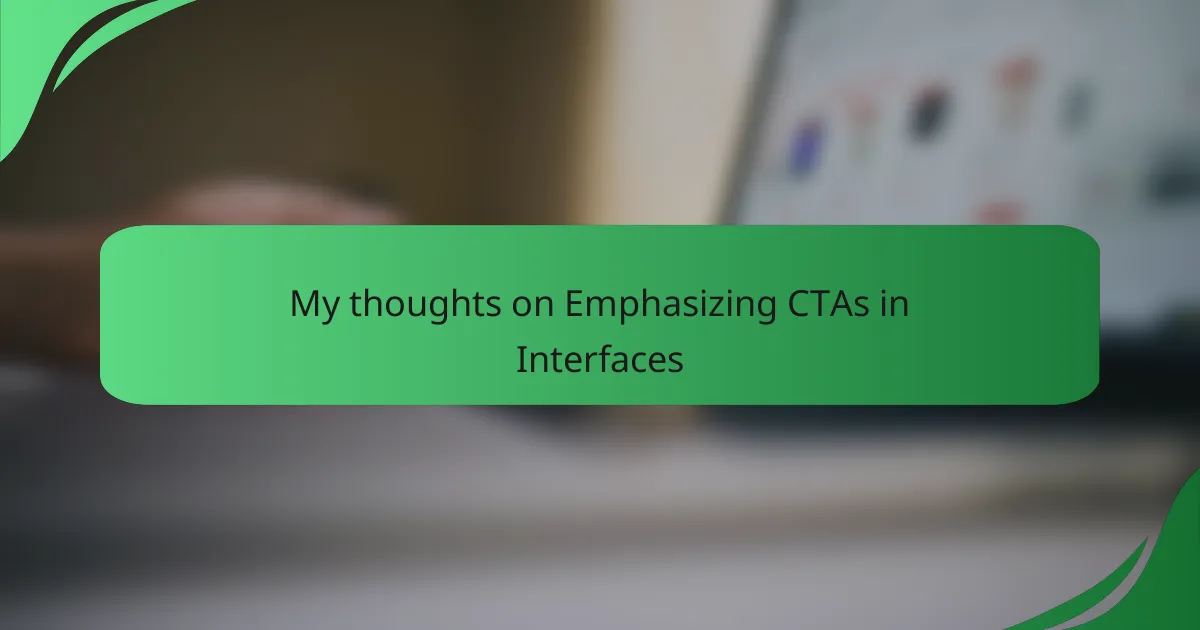Key takeaways
- Microinteractions enhance user experience by providing subtle feedback and guiding users through tasks.
- Well-designed microinteractions can transform mundane waiting times into engaging moments, fostering patience and anticipation.
- Consistency, clarity, and timing are essential principles for effective microinteractions in UI design.
- Ultimately, well-executed microinteractions contribute to higher user satisfaction and foster emotional connections with the interface.

Definition of microinteractions in UI
Microinteractions in UI refer to small, subtle design elements that enhance user experience by providing feedback and guiding users through tasks. I like to think of them as the delightful details that can make a user’s interaction feel more intuitive and engaging. For instance, think of the subtle animation that occurs when you save a document; it’s a small yet powerful way to confirm that your action was successful.
To illustrate the concept further, let’s compare microinteractions with broader interactions in a user interface. Here’s a simple comparison table that highlights their differences:
| Aspect | Microinteractions | Broad Interactions |
|---|---|---|
| Duration | Short, momentary actions | Longer, task-oriented processes |
| Purpose | Provide feedback or enhance understanding | Complete significant tasks or functions |
| User Impact | Increases delight and satisfaction | Achieves goals and productivity |
In my experience, embracing these microinteractions can evoke positive emotions and enrich the overall design, transforming mundane tasks into moments of joy.

Importance of microinteractions in design
Microinteractions play a crucial role in creating a seamless user experience by adding those little touches that often go unnoticed, yet profoundly impact how we engage with an interface. I’ve felt the difference when a subtle animation signals that my message was sent or when a gentle vibration hints at a notification. These tiny cues not only clarify interactions but also make the experience feel more human, don’t you think?
When I encounter well-designed microinteractions, I often find myself smiling. For example, a subtle loading spinner can alleviate the frustration of waiting, transforming it into an engaging moment. This shift in perception demonstrates that good design can soften the blow of delays, and I believe it can foster a sense of patience and anticipation in users.
Furthermore, microinteractions are essential for building trust and confidence. When a user receives immediate feedback, like a slight color change or a checkmark appearing after a successful action, it reinforces their understanding of the task at hand. From my experience, these elements remind users that their actions matter, creating a more satisfying and engaged interaction. Isn’t it fascinating how something so small can have such a big impact?
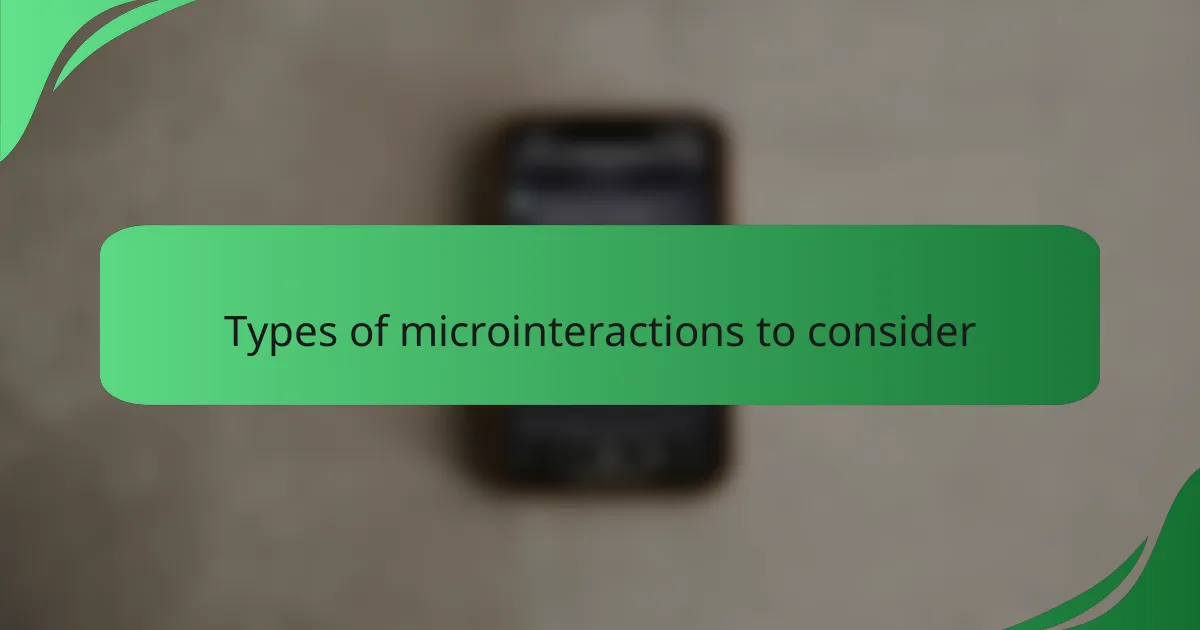
Types of microinteractions to consider
Considering the types of microinteractions to incorporate in your UI design, I find it helpful to focus on feedback mechanisms. Think about the satisfying little animations when you like a post or when a button subtly changes color after being clicked. These responsive elements not only affirm the action but also invite further interaction, enhancing the user’s emotional engagement with the product.
Another key microinteraction type is the status indicator. I always appreciate when a loading animation informs me that something is happening behind the scenes. It diminishes uncertainty and annoyance, making even a brief wait feel more bearable. Have you ever noticed how just a simple progress bar can increase our patience by giving us a sense of time?
Lastly, let’s not forget about instructional cues. For instance, when I see a tooltip gently pop up to explain a feature I’m hovering over, it feels like a little helpful nudge. I remember the first time I used a complicated software and these tooltips guided me seamlessly through its features. They not only educate but also empower users, making complex systems feel approachable and enjoyable.
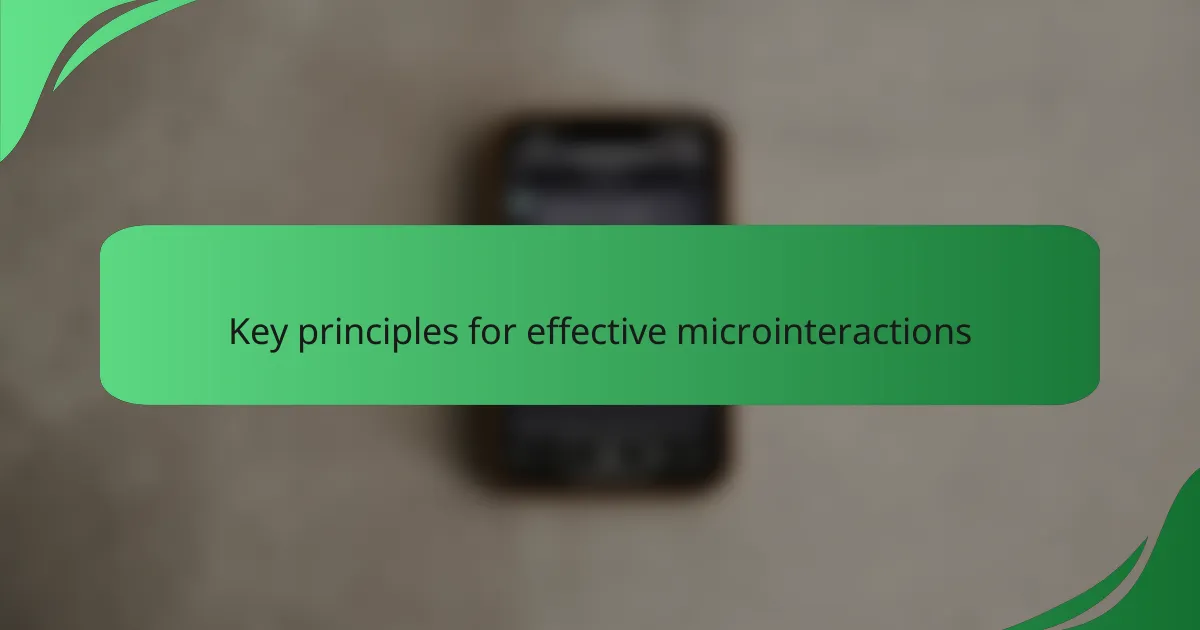
Key principles for effective microinteractions
Effective microinteractions hinge on clarity and purpose. I often find that when these elements are well-defined, users intuitively grasp their function. For instance, I’ve encountered buttons that pulse gently when hovered over, subtly signaling to me that I’m about to take action. This clear invitation makes me feel more confident, enhancing my overall experience.
Another principle I cherish is timing. Microinteractions should occur swiftly but not so fast that they become a blur. I recall a moment when an animation emphasized the completion of a task, allowing me a brief moment of satisfaction. It’s that perfect balance of immediacy and retention that keeps users engaged without overwhelming them.
Finally, consistency is key. I’ve noticed that when microinteractions share a common design language, it fosters a sense of familiarity. For example, using similar animations or color changes across different actions helps me navigate interfaces more smoothly. Isn’t it amazing how uniformity in such details can create a cohesive experience? This consistency builds trust and makes me more likely to continue interacting with the interface.
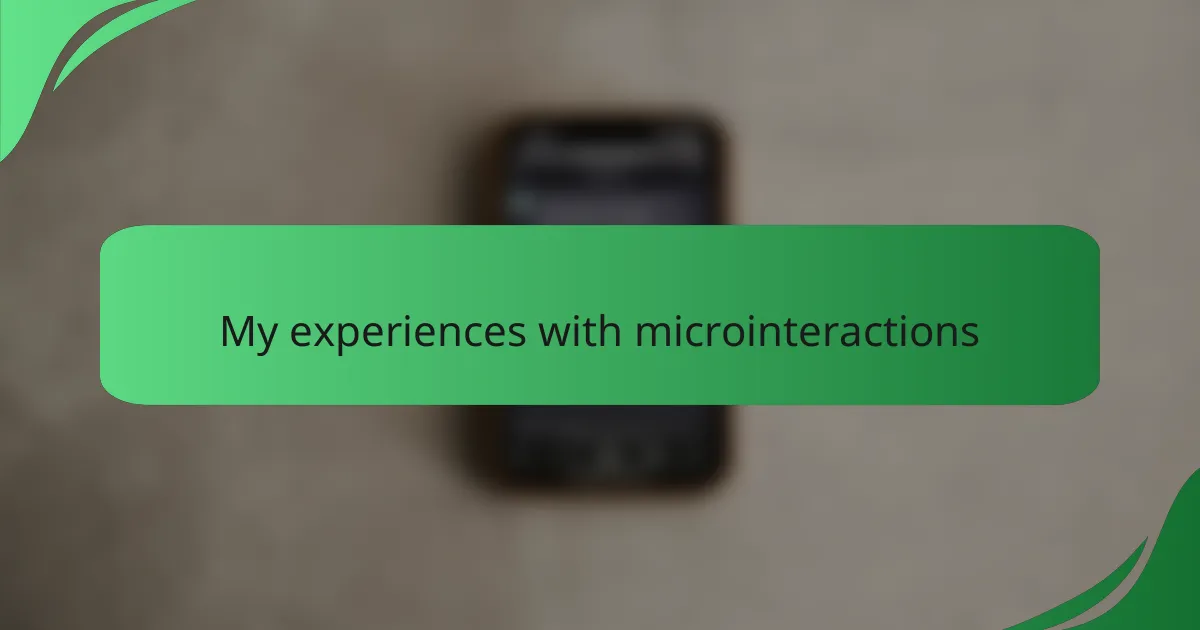
My experiences with microinteractions
When I first started exploring microinteractions in user interface design, I was struck by their power. Simple animations, like a button’s subtle hover effect, can elevate a mundane experience to something delightful. I recall a project where adding a tiny loading animation transformed user impatience into curiosity. Users began to enjoy the wait instead of feeling frustrated. Those moments made me realize how impactful small touches can be.
In another instance, I worked on a mobile application that incorporated subtle sound cues during interactions. At first, I was hesitant about adding sound, fearing it might annoy users. However, after testing it out, I witnessed how a well-timed audio feedback made the entire experience feel more immersive and engaging. Seeing users smile as they navigated the app made the effort worthwhile.
- Microinteractions enhance user satisfaction by creating enjoyable experiences.
- Small animations can communicate status, making users feel informed and involved.
- Thoughtful design choices, like sounds and haptic feedback, make interactions memorable.
- They provide an opportunity for brands to express their personality and values.
- By testing microinteractions, I learned that they can significantly enhance usability.
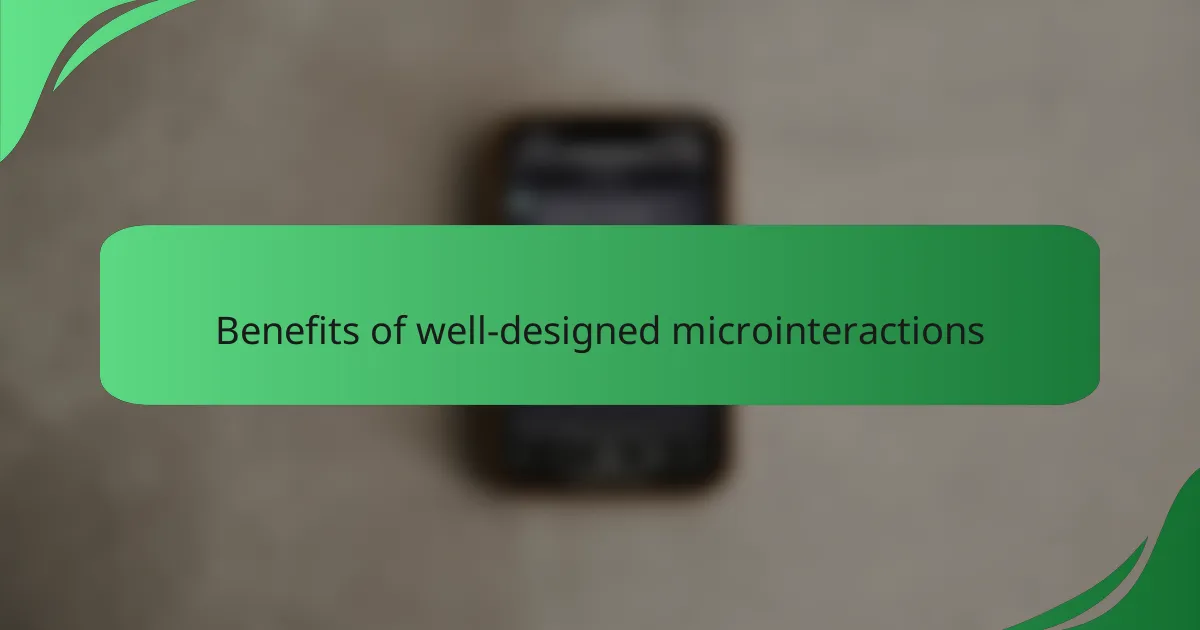
Benefits of well-designed microinteractions
When I think about well-designed microinteractions, I can’t help but appreciate how they enhance user experience. For instance, those subtle button animations that respond when you hover over them don’t just look good; they provide feedback that reassures you your action was recognized. This kind of responsiveness can make navigating a website feel more intuitive and engaging.
Additionally, microinteractions can drive engagement. I remember using an app where the notifications were creatively animated, which made me more likely to interact with the content. It’s these little touches that not only delight users but also keep them coming back.
Creating a seamless experience is crucial, and well-crafted microinteractions play a vital role in achieving that. They can guide users, foster emotional connections, and ultimately improve satisfaction with the interface.
| Benefit | Description |
|---|---|
| User Feedback | Responsive elements provide immediate acknowledgment of user actions. |
| Enhanced Engagement | Creative animations encourage users to explore more of the content. |
| Improved Usability | Guides users seamlessly through tasks, making navigation intuitive. |

